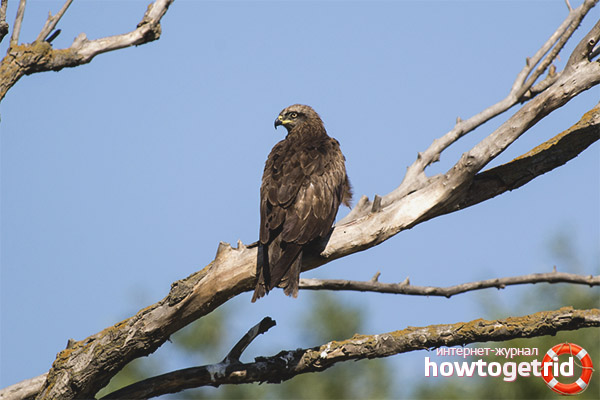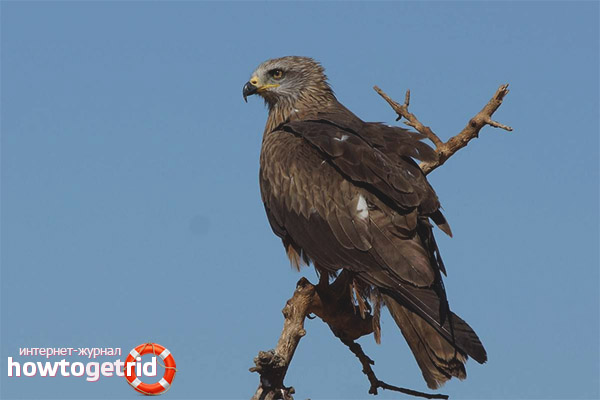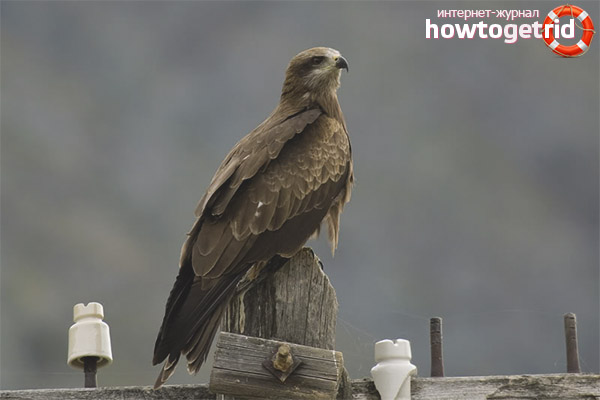The content of the article
The black kite is a bird of prey of the hawk family. It is interesting that the representatives are not painted at all in a black “raven” color, but rather in a dark brown shade. It is easy to recognize it in the sky - one-color plumage, a peculiar fork (not typical for birds of prey), elongated and curved wings. The voice of the black kite is also characteristic - one cannot confuse it with other representatives of the family. Hunters describe his “trills” as the neighing of a foal.
Appearance
The bird is covered with a uniform dark brown sometimes brownish plumage. Only at the end of the wings does the overall shade smoothly turn into black. The belly of the creature is a little lighter, brown.
The kite of prey is very fast and maneuverable due to its small growth - a little more than half a meter. Representatives weigh on average up to 1 kilogram (males are slightly smaller).
The span of the long wings of a predator can reach up to one and a half meters in diameter.
Outwardly, the female and the male practically do not differ, the color of the plumage is the same, only the dimensions of the latter are slightly smaller.
The base of the beak of the black kite is yellowish, and the beak itself is black, slightly bent down.
The legs of the bird are rough and also yellowish with tenacious and long black claws.
Hunting and nutrition
That is, a lazy kite is an excellent hunter, but prefers not to waste energy and strength when you can simply collect edible from accessible places. Often the “table” of the bird is made up of sick or dying animals, wounded animals, and also dead fish thrown ashore.
Such behavior of a feathered predator allows you to give him a prize for "sanitary activity", which is practically not typical for members of the family.
The kite hunts mainly in sharp peaks - in flight with a whistle, the bird tends to prey, clings to it with sharp claws and pulls its beak, killing.
Breeding

During mating season, black kites gather in conglomerates to be able to protect offspring from predators. On average, such a flock totals about 100 individuals.
The males have a characteristic mating behavior in which he fights for the female with other representatives, captivates her with beautiful singing.
After mating, the pair creates nests next to others. On average per 1 square. A kilometer can have about 10 or more nests. Basically, they are organized in the region of the edges and fields on trees (usually on oaks) from 2 to 20 meters high. Sometimes eggs are laid in abandoned alien nests or form a clutch on lake snags.
The nest consists mainly of feathers, branches, clods of earth, a piece of newspaper or rags, prickly bushes, flowers and wool of prey.That is, a black kite, like a crow, carries into the nest everything that “lies incorrectly”. Protect the laying of birds is not enough, for example, when a person appears, they only publish plaintive shouts in the distance. The female can peck and flap wings, and the male dive from above in order to hit the offender with a powerful beak.
The female lays in the nest from 2 to 5 medium eggs. Incubation lasts about a month, during which a caring bird constantly incubates eggs. The male’s help is periodically observed, but the rest of the time he simply obtains food for the family. Chicks become completely independent in one and a half to two months after birth, and reach puberty by 2 years.
The life span of a black kite is about 30 years.
Habitat

Recently, the number of black kites has sharply decreased, which is associated with poaching and human activities (drainage of reservoirs, chemical treatment of fields, deforestation, etc.), and massive natural disasters. A sharp decrease in the number of representatives in the CIS countries, in particular Russia, is observed. Humans and birds coexist poorly.
Basically, black kite lives on the territory of Eurasia (except for the tundra zone), as well as on the Australian and African continents (except for desert areas). These birds are migratory, therefore, with the onset of cold weather (early autumn) they migrate south to warm countries (Africa, Australia, India). There they get along well with local kites.
The highest density of black kites per square kilometer is found in India, with the highest concentration observed in the capital. For 50 thousand square meters. kilometers of the country inhabited by over 20 thousand pairs. The black kite, in terms of the number of representatives in India, ranks second after the Bengal neck.
In Asia, birds have been spotted in Hong Kong, Bangkok and Manila. On the African continent, the black kite was chosen by Arush, Cairo, Bangui and Antananarivo.
The kite of prey is well tamed by humans and is very willing to make contact, which makes it possible to use it when hunting other birds and animals.
Video: Black Kite (Milvus migrans)










Submit